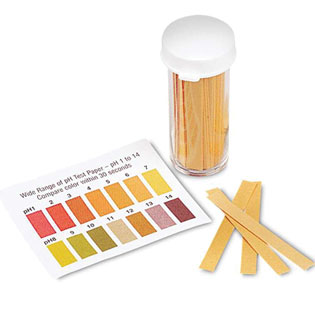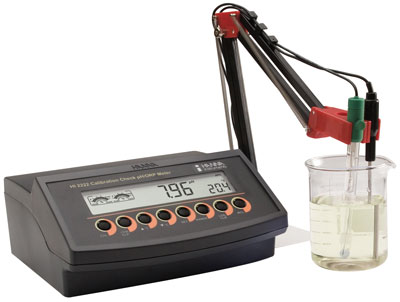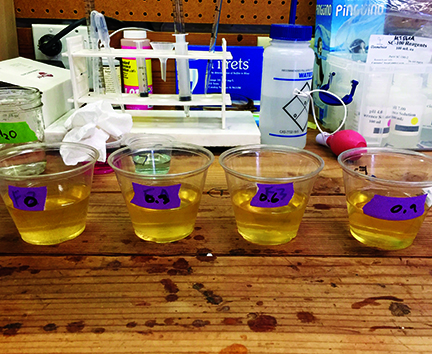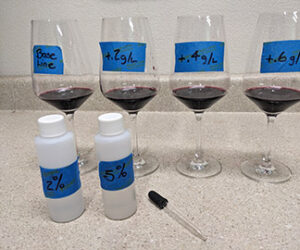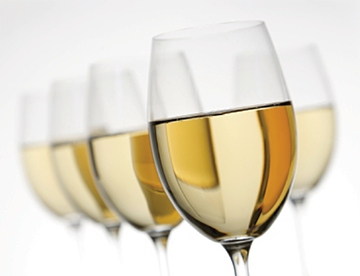 You have been diligent in the use of sulfite, topped up your carboys regularly, and monitored total titratable acidity (TA) at each critical stage of winemaking. But your finished wine has turned out to be a major disappointment. Your red wine is less red than expected. Perhaps it has even turned brown. A white or another red lacks freshness, has matured quickly, or, to your surprise, it has spoiled! What went wrong? The answer may lie in the pH of your wine.
You have been diligent in the use of sulfite, topped up your carboys regularly, and monitored total titratable acidity (TA) at each critical stage of winemaking. But your finished wine has turned out to be a major disappointment. Your red wine is less red than expected. Perhaps it has even turned brown. A white or another red lacks freshness, has matured quickly, or, to your surprise, it has spoiled! What went wrong? The answer may lie in the pH of your wine.
pH is a close relative of acidity, specifically, the total titratable acidity (TA) for wines. TA measures the acid concentration in musts and wines (see “Acidity: A Balancing Act” in the Spring 2001 issue of WineMaker), while pH measures the relative strength of those acids. The pH of wines depends on the pH of the grape juice (also called the must), which in turn depends on such factors as grape variety, type of soil, viticultural practices such as irrigation, the climate during grape ripening and the timing of the harvest. For example, soils rich in potassium or grapes harvested during heavy rainfalls will tend to have a higher pH.
Why should winemakers care about pH?
Two wines with similar TA measurements but different pH will be very different and will evolve differently. A wine with lower pH may show a redder color (in the case of red wines) with greater stability during aging, and will have more fruit and less complexity and body than the higher-pH wine. The lower- pH wine will also mature more slowly — and therefore age longer — and will be less susceptible to spoilage. With that in mind, TA is not sufficient when evaluating a wine. We also need to understand the relative strength of the acid components, or its pH.
It is imperative then to always monitor and control a wine’s pH to ensure that it does not fall below or rise above critical thresholds. Avoid ending up with unexpected and disappointing results. So measure the pH; it’s simple!
Note: All references to TA in this article imply total titratable acidity expressed as tartaric acid.
Understanding pH
Technically, pH is the negative logarithm of the effective hydrogen ion concentration or hydrogen ion activity. As such, pH is often referred to as active acidity. Great! But what does that really mean?
Solutions (such as wine) can have a pH in the range 0 to 14. A pH of 0 represents a strong acid solution, while a pH of 14 represents a strong alkaline solution. Distilled water has a theoretical pH of 7, and wines are in the range of 3 to 4. More specifically, the pH level of musts and wines should be within the following recommended ranges for a desired style of wine.
The pH level is closely related to TA and they are interdependent. Adjustment of either parameter will typically affect the other; however, their relationship is a complex one. TA and pH are not proportional although, generally, raising the TA will result in lowering of the pH, and vice versa. There are cases, however, in which one can reduce both the TA and pH, for example. More on this later.
A low-pH wine will taste tart, owing to the higher acid concentration. Conversely, a high-pH wine will taste flat and lack freshness. A high-pH wine also will tend to oxidize at a higher rate and therefore will not age as well. It will be more prone to microbial spoilage, thus requiring more sulfite. High-pH white wines will tend to brown prematurely. In the case of red wines, color intensity decreases as the pH increases, causing the wine to change from a red to a brownish-red color.
The importance of monitoring and controlling the pH level is also illustrated by the fact that a wine with a pH of 3 is ten times more acidic than a wine with a pH of 4. Using more representative pH values for wine, a batch with a pH of 3.2 is approximately 25 percent more acidic than a wine with a pH of 3.3.
Home winemakers need to be concerned with pH levels that fall outside of the recommended ranges, and take corrective actions as quickly as possible. Slight pH variations within the ranges are not as critical, except when adjusting the free sulfur dioxide (SO2) level (see below). They only become important in specific situations, such as malolactic fermentation (MLF), when the pH level definitely should not fall below the prescribed minimum. Let’s look at how to measure pH, and I will explain how and when to make adjustments.
Measuring pH
A crude approximation of a wine’s pH can be measured using pH paper. To determine the pH of musts or wines, a strip of pH paper is immersed in a sample of the must or wine, and then the color of the paper is matched to a standard set of colors that comes with the kit. Each color corresponds to a specific pH level. Inexpensive pH paper from winemaking supply shops, however, provides inaccurate results — typically varying plus or minus 1 pH unit — and is therefore not a recommended method for precise analysis.
The recommended method is to use a pH meter with a minimum resolution of 0.1 and accuracy of ±0.1 pH unit. A digital stick pH meter with this accuracy costs approximately $50 (US). It is not an essential tool for winemaking from kits, but certainly is a worthwhile investment for people who make wine from fresh juice or grapes, when pH control is imperative.
Similar to TA, the pH level should be measured before the start of fermentation, following MLF, at the end of fermentation once the wine has been stabilized, and following any pH correction procedures. You can also monitor the pH during alcoholic fermentation since pH is more accurate than TA measurements during this phase.
To measure the pH level using a pH meter, the instrument must first be conditioned and calibrated with pre-measured pH buffer solutions. To do this, just follow the manufacturer’s instructions. This involves dipping the pH meter probe in a 7.0 pH buffer solution that comes with the meter, waiting for the meter to calibrate, and repeating this procedure with a 4.0 pH buffer solution. After calibration, the probe is simply immersed in a sample of must or wine to take a measurement.
To improve the accuracy of the pH measurement, any carbon dioxide present in the sample should be removed by a vigorous stirring. Additionally, you can apply a little heat to accelerate dissipation of the gas. Remember to let the sample cool back down to room temperature before taking a reading.
A fresh supply of pH 4.0 and 7.0 buffer solutions is required for calibrating your pH meter before measurements. Since home winemakers tend to use their pH meter infrequently throughout the year, it is best to re-calibrate it before each use to ensure proper results.
Before we look at pH correction methods, let’s first examine the relationship between a wine’s pH and the level of free SO2. The method you select will be a function of both measurements.
The relationship between pH and SO2
Free SO2 is what protects the wine against oxidation and microbial organisms that could spoil the wine. More specifically, molecular SO2 is the active component of free SO2, and its effectiveness is dependent on a wine’s pH.
Home winemakers really don’t need to understand the technical details. What’s important is that we need to account for the pH level when sulfiting, since pH affects free SO2 effectiveness. What you should remember is that as pH increases, free SO2 loses effectiveness, and therefore you need to add more sulfite to protect the wine. (For more details on measuring and controlling free SO2, refer to “Solving the Sulfite Puzzle” in the Winter 2000 issue of WineMaker.)
As a rule of thumb, you should target a free SO2 level of approximately [(pH-3.0)x100] mg/L for red wines; for white wines add 10 to this value. This calculation assumes that your wine has a pH above 3.0. For example, if a white wine has a pH of 3.4, the amount of free SO2 should be [(3.4–3.0)x100+10] = 50 mg/L, or 50 parts per million (ppm). The same wine, but with a pH of 3.7, would require 80 mg/L to maintain the same free SO2 effectiveness.
If your wine’s pH is above the recommended range, you should try to lower that pH down to within the range as your first course of action. Pick a pH correction method that achieves results quickly, such as adding tartaric acid. Re-measure the pH, and when it falls within the recommended range, measure the free SO2 concentration and adjust it according to the rule of thumb.
Remember to compensate for any free SO2 already present in the wine. For example, if you measured 30 mg/L of free SO2 in your wine, you need only add 20 mg/L if you want to achieve 50 mg/L. This requires adding approximately 700 mg (0.025 ounces) of potassium metabisulfite or 1.5 Campden tablets to a 19-liter (5-gallon) batch of wine.
How to correct pH
As with TA, the pH level of concentrates and sterilized juices are adjusted during their preparation for commercialization. Generally, home winemakers need not be concerned with pH correction for these musts. Still, it’s good practice to keep a log of pH measurements to detect potential problems early. In the case of wines produced from grapes or fresh grape juice, the pH level should always be measured as it may require adjustments.
There are various methods to increase or decrease the pH level of wine depending on the desired results, namely, which acid (or acids) you want to effect. These winemaking methods include:
•Adding tartaric acid or acid blend to raise the TA and lower the pH.
•Blending wines of different pH to increase or lower the pH.
• Adding potassium bicarbonate or ACIDEX® to remove some acidity and raise the pH.
•Carrying out a malolactic fermentation (MLF) to raise the pH.
•Cold stabilizing the wine to reduce acidity, which can increase or decrease pH.
•Simply adding water to dilute the acidity and increase the pH.
The table (see above) summarizes the effects of pH correction methods on the various acids that are present in wine.
Acid additions
Tartaric acid addition is an effective method to lower the pH in high-pH wines because it is the strongest acid, it is present in higher concentrations than other acids, and is also easy to control. Since we are adding an acid, acidity and TA increase, which in turn lowers the pH. Acid blends achieve the same results; however, they may contain citric acid, which is not a recommended wine additive since it has an excessively sour taste. It is also partly transformed into the undesirable acetic acid, responsible for a vinegary smell and taste, during alcoholic fermentation and MLF. So pick an acid blend that has little or no citric acid.
Tartaric acid crystals are used at the rate of approximately 1 g/L (0.13 ounce/gallon) of wine to reduce the pH by 0.1 unit. For example, to reduce the pH of a 19-liter (5-gallon) batch of wine from 3.6 to 3.4, you need to add 38 g (1.3 ounce) of tartaric acid crystals. The crystals should first be dissolved in a small volume of wine. The solution is then added to the must before the start of fermentation. If the wine will be cold stabilized, the rate of addition can be increased to 2 g/L (0.26 ounce/gallon).
Note that the tartaric acid addition should be done before the start of fermentation. This goes back to the relationship between pH and free SO2. The pre-fermentation acid addition raises the TA, and therefore lowers the pH. During alcoholic fermentation and MLF, TA decreases, causing the pH to increase. The pre-fermentation addition reduces the risk of the pH rising above the range at which free SO2 loses effectiveness. If you add the tartaric acid after fermentation and MLF, you risk shooting the pH too high.
When adding acid blends, use the same rate of addition as tartaric acid, do a measurement, and re-adjust as necessary. You will have to use this trial-and-error method since you usually don’t know the ratio of acids in the blends. However, since they contain malic and maybe citric acid, the blend will be less acidic than a purely tartaric acid blend. You would then have to slightly increase the rate of addition to achieve similar results.
Blending batches
Blending is a highly recommended method for adjusting pH in wines, because it is a natural method and does not involve the use of chemical additives. It can be used for either increasing or decreasing the pH. Its only drawback is that you may not always have the required wines with the needed pH to obtain the desired result.
Given this drawback, the best way to make any correction is to blend the wine to be corrected with another wine of known pH. If the wine to be corrected requires the pH to be increased, then use a higher-pH wine for blending. Similarly, use a lower-pH wine if the pH needs to be decreased.
Mathematical determination of the resulting pH in a blended wine is complex. An easier method is to calculate the TA of the blended wine using the Pearson square calculation, verify the calculation by titration, and then measure the pH. (To see a Pearson square and learn how to use it, see “Acidity: A Balancing Act” in the Spring 2001 issue of WineMaker.) Then make any adjustments as required to achieve the desired TA and pH.
On rare occasions, you may find yourself with a wine having both a high TA and a high pH. The TA may be acceptable, but you would like to reduce the pH without affecting the TA. The ideal solution would be to blend this wine with another having the same high TA but a low pH. Quite a challenge! You most probably do not have reserves of that many different wines.
Some winemakers make use of phosphoric acid to reduce the pH level of a high-TA, high-pH wine without significantly altering TA. I do not recommend it as it changes the taste and texture of wine. Phosphoric acid is actually not allowed as an additive in U.S. commercial winemaking.
Acid reduction
Acid reduction using potassium bicarbonate or other acid-reducing agents, such as ACIDEX®, can be used to raise the pH in wines. Potassium bicarbonate raises pH by reducing tartaric acidity and is therefore recommended for high-TA, low-pH wines. Dissolve potassium bicarbonate at the rate of 1 g/L of wine for each 0.1 unit increase in pH. For example, for a 19-liter (5-gallon) batch of wine with a pH of 3.2, 38 g (1.3 ounces) of potassium bicarbonate is required to increase the pH to 3.4.
Other products, such as ACIDEX®, can be used to increase pH by reducing tartaric and malic acids in approximately equal parts by precipitating them in their salt forms — a chemical process known as double-salt precipitation. The advantage of these products is that the precipitated solids can be separated from the wine within 30 minutes. Follow the manufacturer’s instructions as each product may have handling differences.
Malolactic fermentation
Malolactic fermentation (MLF) is a secondary fermentation caused by malolactic bacteria that converts the stronger and harsher malic acid into the softer lactic acid. MLF is not usually used to raise a wine’s pH, but rather, to make a desired style of wine, for example, a wine with softer acidity. The net result is still lowered acidity and increased pH. Therefore, MLF can be used to raise the pH of a wine but it is not the primary decision factor.
That said, I recommend letting MLF take its course to completion to achieve the desired style, and then measuring pH to make sure it is within the recommended range. Using this method to achieve a desired precise pH change is difficult, because we have no simple method of determining the amount of malic acid present that will be converted. Then use one of the other methods to make any necessary adjustments. Remember to also keep an eye on free SO2.
A few words of caution when conducting MLF: Malolactic bacteria are sensitive to a low pH and may perform sluggishly under such adverse conditions. In fact, MLF may not start at all. Be sure to follow the manufacturer’s instructions regarding the minimum pH required. Typically, ML bacteria require a pH above 3.2.
MLF has a few drawbacks and dangers for home winemakers. The progression of MLF requires careful monitoring and control. If allowed to progress to an unusually high pH level, the wine will oxidize prematurely and will become prone to bacterial infection.
Cold Stabilization
Cold stabilization is tricky! The procedure involves placing the wine in cold storage at a temperature between 25° and 40° F (-4° and 4° C) for a minimum of three weeks and then racking it. This has the effect of precipitating the tartaric acid as potassium bitartrate salt — the tartrate crystals you find at the bottom of a bottle of wine that you forgot and left in the fridge for too long — which decreases acidity and hence TA. However, remember that potassium contributes to a higher pH. When it precipitates during cold stabilization, it then lowers the pH. This effect actually happens at a pH of 3.65 (use 3.6 if you have a 0.1 precision pH meter) or lower because of the relative concentrations of tartrate and potassium in the wine. At a pH of 3.65 or above, cold stabilization will actually raise the pH.
As a guideline, you can assume a 0.1 pH unit increase or decrease for every 1 g/L decrease in TA. The precise amount of potassium bitartrate to be precipitated is hard to control because of temperature and duration factors. Therefore, cold stabilize the wine, measure the TA and pH, and adjust accordingly.
Water addition
Adding water to wine is a simple method for increasing pH. By adding distilled water (tap water may have a significantly different pH than the theoretical value of 7.0, and may also contain undesirable substances such as chlorine), we are effectively diluting the acids thereby reducing TA and increasing the pH. Many home winemakers use this method, although it is not practiced and is not allowed in commercial winemaking. The major disadvantage is that the flavors, aromas and bouquet also get diluted, resulting in a “watery” wine with less complexity. Therefore, use this method only when small pH changes are required to avoid adding too much water.
Simply insert the pH meter probe in the wine and add distilled water until the desired pH is reached. Make sure that the TA is still within the recommended range. You should also measure the pH of the water being added to better predict the results. The reason is that the pH of water may actually change considerably depending on how it was stored.
The final word on pH
All this techno-jargon about acidity and pH may seem complicated and overwhelming. These are important concepts for successful winemaking. It helps to first get comfortable with the concepts and effects of acidity and pH in wines.
Lisa Van de Water, of the Wine Lab at Napa, best summarized the effect of pH on wines in an article by Donald E. Gauntner in the Winter 1997 issue of the American Wine Society Journal: “At lower pH, red wines are redder, fresher, fruitier, younger tasting for their age, slower to age, slower to mature, less complex, less full-bodied, much slower to spoil, and easier to maintain free of spoilage in the cellar because the SO2 is more active at the lower pH. Higher pH wines, if they are red, are less red (sometimes brown, sometimes purple), less fresh, less fruity, more complex, more full-bodied, faster to age, faster to mature, easier to spoil, and more difficult to manage in the cellar with SO2.” Use these words as your guiding principles and you will turn out excellent wines.


